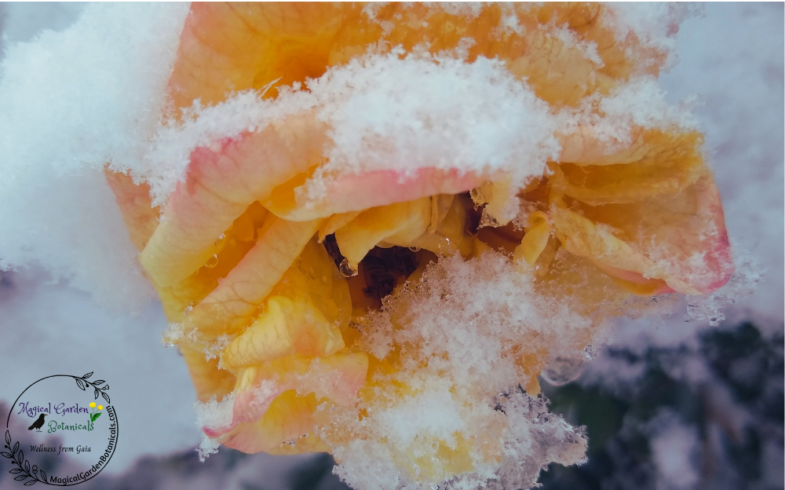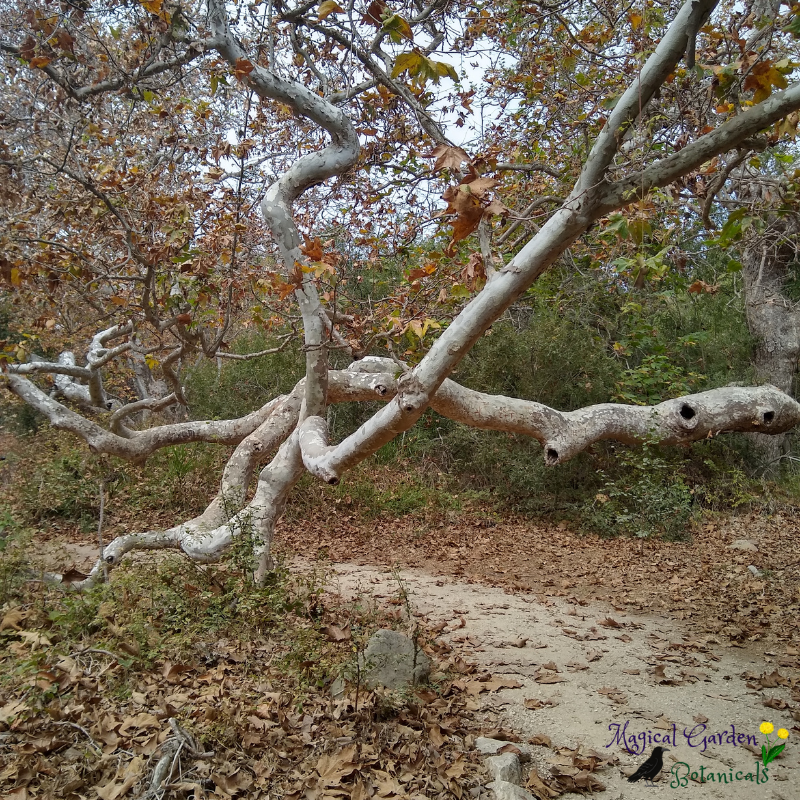Shifting Seasons in the Magical Garden
During autumn, we hear the sentiment that the seasons remind us that change is beautiful. I’m usually not one to receive change with open arms; on the contrary, I often kick and scream all the way. However, once I get to the other side, I will usually look back and realize it was a good thing. I relish my routines, even though I keep a relatively fluid schedule with most of my daily life. When the seasons change, it is a significant shift for me. The transition from summer to autumn creeps in with a little bit of melancholy. The Magical Garden has reached its high point, and the majority of the plants have completed their blooming cycles and are now producing seed.
There is beauty in this.
While some may see the ending and death of the plants, I see promises of new beginnings.
This means my time will shift from tending the garden to prepping remedies with the plants I had harvested and dried. It’s time to organize and make plans for the coming season. It’s also an opportunity to reorganize the apothecary. I am being called to begin turning inward. Despite my apparent reluctance to change, I enjoy this time very much as autumn is one of my favorite seasons, and it paves the way for another season that I gratefully adore.
So why the bit of melancholy? It’s more than the idea of having to change routines; it is saying bye to the plants. Although it isn’t a forever goodbye, more of a goodnight as the plants go dormant until the spring. Thankfully, some plants are present during winter, including thyme, rosemary, and calendula. However, the majority of the plants will go dormant or reappear from seed. It’s like saying goodbye to dear friends. You know they will return but still shed a tear as you wave goodbye to them as they leave.
Wisdom from a tree
On a recent visit to the coast, I had the opportunity to convene with a beautiful sycamore tree. A sprawling tree with her branches spread out twice her height, they curved and curled around the path with an impressive amount of grace and strength. As we hiked a small wooded area along the coastline, I felt called to her. And when I stopped to admire her branches, she shared this with me.
Some view life as linear, having a beginning and an end. A straight line if you will. On the contrary, life is a wheel that is in constant motion. If you look closely you will see there are twists and turns, similar to my branches, but when you step back you definitely see that it is a circle. All life is in a constant cycle of birth and death. It may appear that the plants are dying in autumn, in reality, they are very much living. The annual plants are dropping their seeds- little copies of themselves that will slumber and reemerge when the time is right. The perennials are driving their energy towards their roots so that they may hibernate during the colder months. Many of the trees are also prepping for the change in the season. Autumn is a season of preparations. Preparing for the time of the year that the plants turn inward, a time of hibernation, a time to reflect and slow down.
Gaia’s critters visit the Magical Garden
The Magical Garden welcomes a variety of creatures throughout the year. Hiding in a plant or perching majestically on a poplar tree, visits like this are always a blessing. These critters included large milkweed bugs, turkey vultures, praying mantis, dragonflies, and katydids during late summer and autumn.
Large milkweed bugs are seen attending a milkweed plant. I appreciate their presence in the garden as they help reduce the quantity of milkweed that appears each year. Some years bugs are abundant, and other years not so much. However, I am grateful for them since they maintain balance in the garden.
Turkey vultures migrate in large numbers through our area in the spring and autumn. They are awe-inspiring creatures. In the past few years, a large group of them have chosen to roost in our poplar trees overnight. It was exciting to witness them in the early morning as they prepared to take flight to continue on their migration. They were pretty curious about us as we welcomed them to our trees. The ravens weren’t too happy about these enormous visitors claiming their usual perches.
This particular praying mantis was hiding in a yarrow plant. At first, I didn’t see her as I harvested a few leaves. She was camouflaged so well within the branches. Praying mantis are fascinating creatures, and I genuinely welcome their visits to the garden.
Dragonflies are magical to their very core. Their iridescent bodies are sprinkled with luminous enchantment. One day, this one appeared in the garden as I sat outside having a lovely chat with a dear friend. While I won’t share the details of our conversation, this beautiful creature confirmed the information we had just shared. A blessing to behold, he stayed a while and allowed me to photograph him.
A small harvest of yarrow leaves for an herbal wand produced a small branch that included some guests. These guests were katydid eggs. Although I usually look before I cut plants in the garden, this little grouping of eggs must have escaped my field of vision. So I placed the branch in a safe place to hatch when they were ready. Katydid nymphs like to dine on aphids, so they are welcome in the Magical Garden. Yes, the mature insects eat leaves, but I’ve got enough to spare.
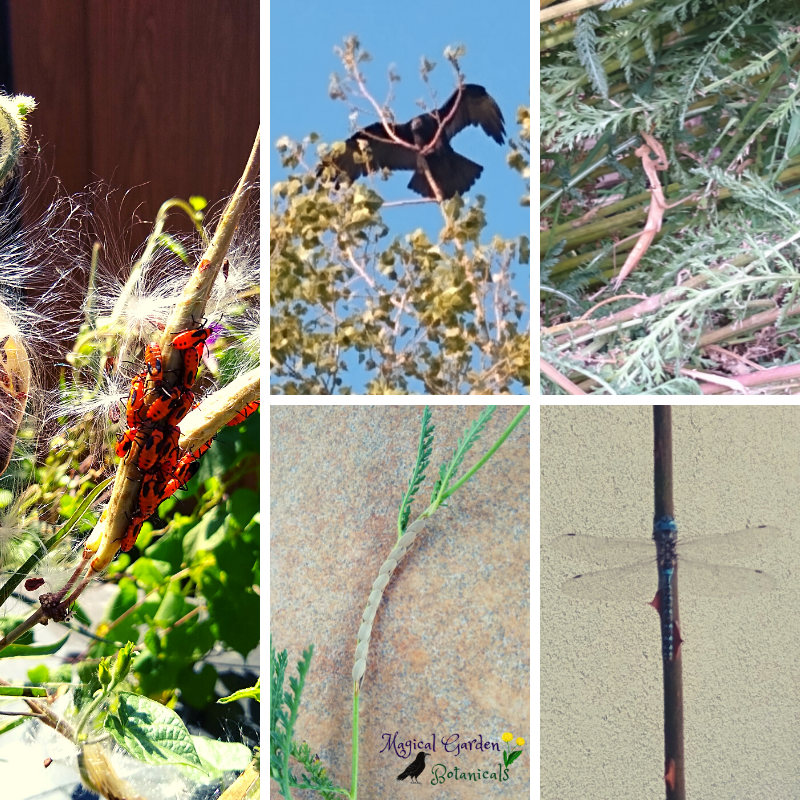
Time to dig roots
Autumn is the time of the year to begin harvesting roots. As the days progressively cool, the plants go dormant as they store their energy in their roots. The most commonly harvested roots in the Magical Garden include mullein, marshmallow, dandelion, horseradish, echinacea, California poppy, and plantain. I enjoy digging up roots. It encourages me to slow down and practice mindfulness, as hastiness can damage the roots or the surrounding plants. And while doing this, I find that I connect more with the plants. As we dig into the soil, we ground ourselves with Mother Earth. Sycroniticy abounds as this is the time of year synonymous with slowing down and turning within.
The marshmallow (Althaea officinalis) plant in my garden was ready for a root harvest. I harvested the roots carefully not to damage the plant while taking what I needed. And that still proved to be quite a bit. As I began to dig the roots, I found that they had grown out of the bottom of the pot and into the soil.
Marshmallow root is a cooling and moistening mucilaginous herb. To get the most potent extraction of mucilage, the best method is a cold water infusion. To make a cold infusion, use 2-4 grams of root to 1 cup of cold water and infuse overnight. Strain in the morning. It will be very thick and, as described by some, will have “a snot-like” consistency. Marshmallow root is beneficial to inflammatory disorders of the gastrointestinal tract. Topically it can be used on wounds, varicose veins, and sunburns as it has vulnerary and emollient properties.
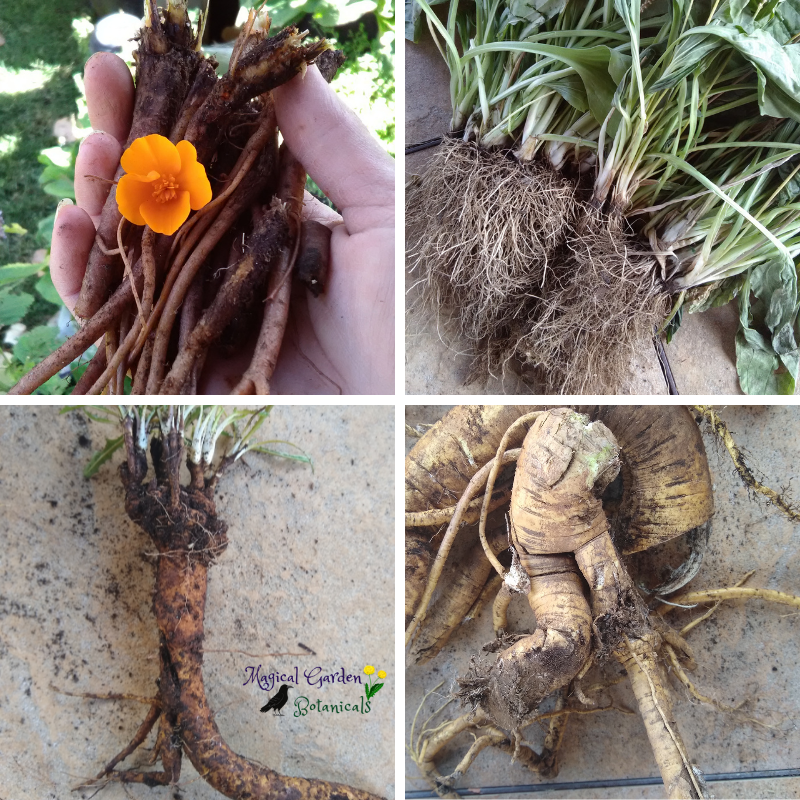
Clockwise from top left: California poppy (Eschscholzia californica), plantain (Plantago major), marshmallow (Althaea officinalis), and dandelion (Taraxacum officinale).
The first snow of the season
At the time of this writing, we were blessed with the first snow of the season- it was a welcome sight after a very long dry summer.
As the nights become progressively colder, the Winter Solstice approaches and calls in the season of introspect. It is a time to go inward, hibernate, and secure our roots within the soil. It is my most favorite time of the year.
It finally feels like winter in the Magical Garden.
Wishing you and yours many bright and beautiful blessings this holiday season.
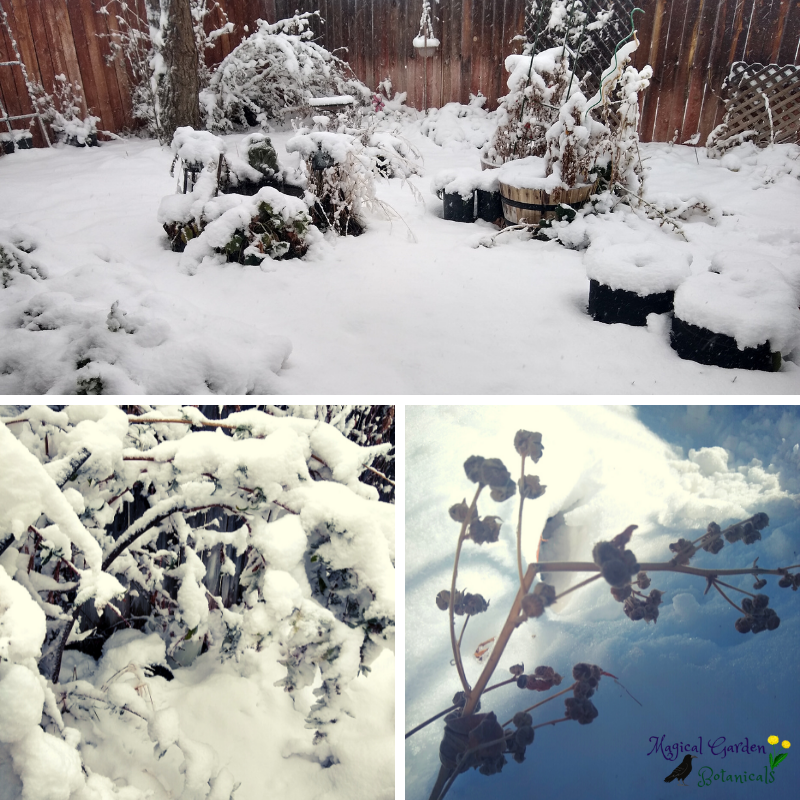
Top image: The Magical Garden covered in snow. Bottom left: Faeries were spotted playing under the snowy archway. Bottom right: Marshmallow plant peeking up from the heavy snow.
This blog is for informational purposes only and is educational in nature. Statements made here have not been evaluated by the FDA. This blog is not intended to diagnose, treat, cure, or prevent any disease. Please discuss with your own qualified health care provider before making any dietary or lifestyle changes.


Daughter of the Earth, Mother of her creations. Ivanna (Evie) doesn’t care for titles, but the ones that fit best are homeschool mom, herbalist, and blogger. Her greatest joy is guiding others to find true wellness within themselves and Mother Earth. When not spending time with her beloved family, she can be found researching everything related to holistic wellness, crafting herbal remedies, or visiting with the plants in the Magical Garden.

